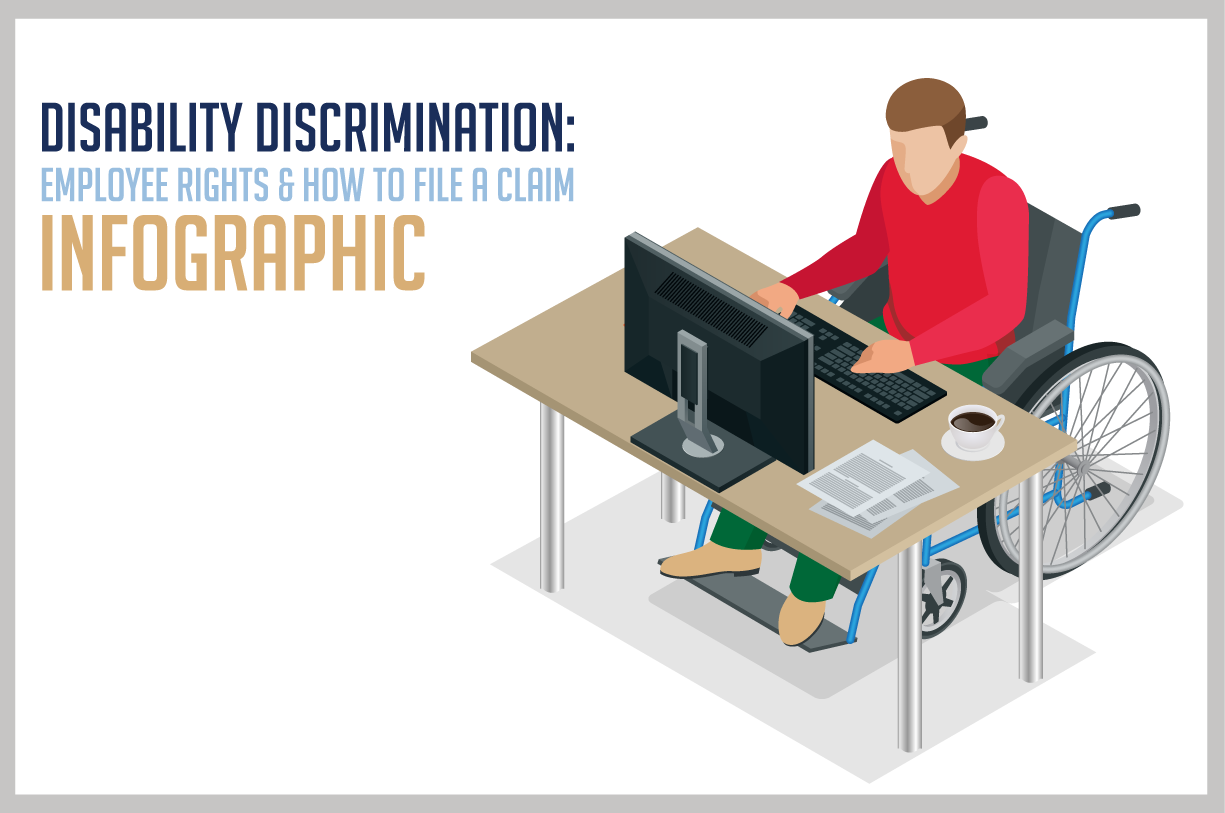
Posted on January 3, 2017 in Disability Discrimination
The U.S. has taken great steps to protect the disabled at work over the past 75 years. There are national and state laws in place that define the rights of the disabled and what employers are required to do to accommodate these persons at work. The consequences for employers who don’t follow these laws are extremely costly. Employees who have experienced disability discrimination in the workplace may be compensated if they choose to act against a violating employer. If you feel you’ve been a victim of disability discrimination, this graphic will help you understand the steps you can take to file a claim against your employer.

[gdlr_toggle_box style=”style-2″ ]
[gdlr_tab title=”CLICK HERE TO SEE INFOGRAPHIC AS TEXT ONLY” active=”No”]
Disability discrimination is when an employer or other business entity covered under the Americans with Disabilities Act (ADA) or Rehabilitation Act treats an employee or applicant unfavorably due to a disability.
Prohibits discrimination against individuals with disabilities in programs run by federal agencies and programs that receive federal funding. Sections 501 and 503 focus specifically on the disabled employees.
Applies to…
Federal agencies, federal contractors, and recipients of federal financial assistance.
Prohibits discrimination against individuals with disabilities in all areas of life. The goal is to make sure individuals living with disabilities have the same rights and opportunities as anyone else in society. Title I focuses specifically on employment.
Applies to…
All employers in the private sector with more than 15 employees.
Requires employers to take “reasonable” steps to prevent and correct discrimination and harassment to employees. Employers are required to create detailed written guidelines that prevent harassment, discrimination, and retaliation.
Applies to…
All employers with five or more employees.
The median annual household income among households that include any working age (21-64) people with a disability, in the United States in 2014. = $42,000
The median annual household income among households that do not include any working age (21-64) people with a disability, in the United States in 2014 = $64,100
The median annual earnings of non-institutionalized persons aged 21-64 years with a disability in the United States who were working full-time/full-year in 2014 = $39,300
The median annual earnings of non-institutionalized persons aged 21-64 years without a disability in the United States who were working full-time/full-year in 2014 = $44,400
The percentage of non-institutionalized persons aged 21 to 64 years with a disability, in the United States who were living below the poverty line in 2014 = 28.1%
The percentage of non-institutionalized persons aged 21 to 64 years without a disability, in the United States who were living below the poverty line in 2014 = 12.1%
With no disability = 73 %
With a disability = 33.8%
Employed full-time = 116,240,000
Employed part-time = 24,129,000
Employed full-time = 3,025,000
Employed part-time = 1,225,000
Employed full-time = 113,215,000
Employed part-time = 22,903,000
Number of disability discrimination cases are on the rise:
Year # of Cases
2005 14,893
2006 15,575
2007 17,734
2008 19,453
2009 21,451
2010 25,165
2011 25,742
2012 26,379
2013 25,957
2014 25,369
2015 26,968
Employers are required to provide what is known as “reasonable accommodation” for employees considered disabled. Reasonable accommodation is any change or adjustment to a job or work environment that allows an individual with a disability to participate.
Reasonable accommodation may include:
Report the incident(s) using your company’s established process for anti-harassment and discrimination claims. It’s important to back up your claim with legitimate evidence.
Keep a detailed log of the incident, including the dates and times that the discrimination occurred along with any records regarding your attempts to report the incident(s).
Speak with fellow employees you trust to ask if they would be willing to speak with a representative during your claim. If possible, have them explain why they feel you have been discriminated against.
Lawsuits are complicated and we recommend speaking with an attorney who has direct experience with disability discrimination lawsuits.
Each of the laws governing disability discrimination requires the filing of an administrative complaint with the appropriate state agency – this must be done promptly! In general, for claims of discrimination under federal law, this must be done within 300 days of the unlawful act; for claims under the California law, it be done within one year of the unlawful act. If you fail to timely file these administrative claims, you will be barred from proceeding with a lawsuit.
After filing with the appropriate administrative agency, the agency may go after the employer on its own. However, more often than not, they chose to simply issue a “right to sue” letter, which then allows the aggrieved employee to file suit. If you file a lawsuit without a “right to sue,” your lawsuit will be barred from proceeding.
Once you have received your “right to sue” letter, you must promptly file your lawsuit or, again, you will be barred from doing so. In general, for claims filed under federal law, you must file your lawsuit within 90 days of receiving your “right to sue”; for claims filed under California law, you must file your lawsuit within one year from the date your right to see letter is issued.
Lawsuits involve a great deal of work. Your attorney can only work effectively if you provide him/her with the necessary facts and information. It is a collaborative process between the attorney and the client. As I say, I am the machine gunner and the client feeds me the ammo (facts and info).
If believe you or a loved one has a disability discrimination case, you should speak with the expert San Diego attorneys Walker Law today. Our team has years of experience handling disability discrimination cases and is committed to fighting for you. Call us direction at (619) 839-9978 to schedule your free consultation.
[/gdlr_tab]
[/gdlr_toggle_box]